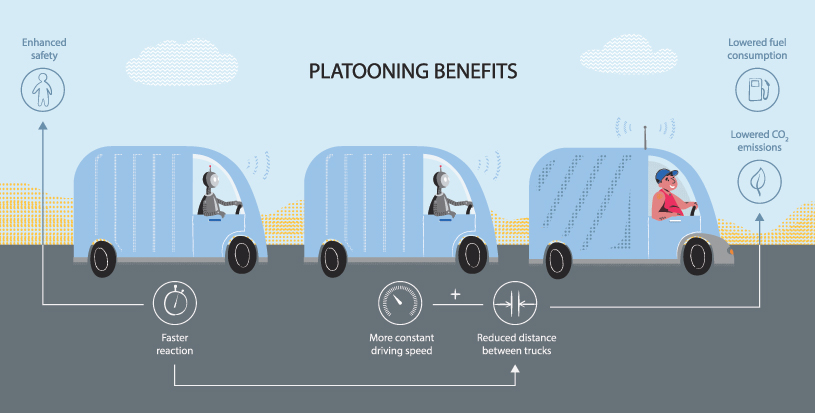Why that truck is tailgating, electric car economics and other changes to S.D. roadways
Dec. 27, 2018
This paid piece is sponsored by SDN Communications.
By Vernon Brown
South Dakota Department of Transportation employees are working with neighboring states to test high-tech trucks on I-90. They’ll be radar-controlled and follow each other at a distance other drivers might consider tailgating.
It’s called platooning. The lead truck is followed precisely as close as 40 feet by the next truck, thanks to its radar control. The system has been tested in other parts of the country. Now, South Dakota is working with Minnesota, North Dakota, Montana and Wyoming to test platooning across their long interstate stretches. I-94 will be part of the testing in some of the other states.
David Huft, a South Dakota Department of Transportation researcher, is responsible for developing the state’s intelligent transportation system. He told SDN Communications, its member telephone companies and Public Utilities Commission officials and staff earlier this month that fuel savings will push platooning.
The shorter distance between trucks cruising down the road creates drafting, saving 5 percent in fuel efficiency for the lead truck and 10 percent for the autonomous follower.
“That’s real money when you’re talking about fueling trucks,” Huft said.
Huft also predicts a merging of sorts between highway and IT engineers as concrete construction meets the proverbial information superhighway.
Interstates will need embedded sensors to gauge road conditions. And as connected vehicles evolve, variable speed-limit signs might “talk” to driverless cars and slow them down for bad weather, construction zones or other hazards. That will require considerable broadband networking.
Fortunately, SDN and its owner companies, the independent telephone companies of South Dakota, have fiber deployed in the rights of way of nearly all highways. That fiber investment could speed connectivity for autonomous cars in South Dakota.
Huft said the developments will require transportation professionals and elected leaders to update road policies.
“When an officer pulls an autonomous one over and there’s no driver, just passengers, what will he do? Who is responsible?” Huft asked. “If I’m drunk but not really driving, am I committing a crime?”
Plus, state government relies heavily on gas taxes to fund roadwork, but Huft said electric car use is growing dramatically and will overtake the highways with no real financial contribution to the roads they use.
Electric cars are becoming cheaper for owners to operate, Huft said. Five-year electric costs to run a car total $1,500 compared to $15,000 for gas, and electrics have a life expectancy 2 1/2 times greater because of fewer moving parts. While $60,000 Teslas are the top-selling electric luxury car, other lower-cost electrics are becoming competitive in price.
“I don’t often buy a new car, but my next one may be electric,” Huft said.
Smart cars of the future will be electric, reducing gas emissions. And those cars that won’t rely on a human driver will give more independence to people with disabilities or the elderly who can’t operate a car today. Huft also predicts a dramatic reduction in deadly crashes, which claim nearly 35,000 U.S. lives annually.
Sioux Falls-based SDN Communications is a leading, regional provider of broadband connectivity and cybersecurity services for businesses. Business leaders who would like information about the company and its services may call 800-247-1442 or explore sdncommunications.com.








